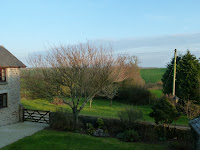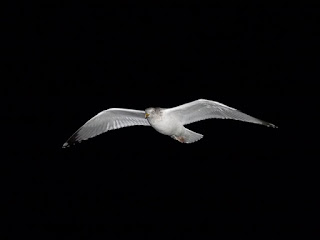Yesterday I went on my first ever bat group outing. I arranged to meet the other members in a car park in Cornwall at 11am. I was warned I may get muddy, and wellies were a definite.
Not thinking much of this (getting muddy and requiring wellies is almost a given with most conservation activities), I set off to meet them. After a few initial identification issues, I found the group and was given a battery pack (the size of a novel, but the weight of a reference book!) to strap around my waist, under my coat. This had a lead going up to a lamp which I had to attach to the front of my helmet. This done, and introductions made, we set off.
Getting to know a few of the people on the walk to the first site, I was treated to a few anecdotes about what lay in store for me. I, having never been on a bat outing ever, was completely in the dark about what was to happen. The most I had gathered was that we were visiting about 5 hibernacula near to the carpark, and once inside, we would count the bats and record what species they were.
These anecdotes though, filled me with dread. Horror stories of the 80's where health and safety was a little less stringent than it is today; stories of caves on cliff faces, and safety ropes coming loose, I thanked my stars that we are not on any beach, and it was no longer the 80's.!
The first hibernacula, was to be 'a bit of a squeeze' and the majority of the group would not actually fit inside. This one, I was also told, resembled a badger set from the outside. A badger sett?! I'm going to be sent in a badger sett?!
Now I'm sure you can imagine what must be running through my mind at this point...I have to squeeze myself, in full outdoors gear, down a muddy hole in the ground, that looks essentially like a badger set. I am also not what I would describe a slight of figure, so now I am really beginning to wonder if I am actually capable of doing this full stop.
Nevertheless, we reached the first site, and sure enough, it was a small hole in a bank, that did resemble a badger sett. I was told not to worry, that only 'Luke' was to be going down this one, and should he need assistance to get out, we were all there to pull him out. Down he went, it took about 2 minutes for him to shimmy his way down about 3metres through an even smaller hole at the end, where, I was told, he could stand up as the adit opened up. After losing sight of him completely for a few minutes, he shouted up that there was one lesser and one greater horseshoe bat. He then reappeared and grappled his way back up the muddy slope; an extremely difficult task given he could barely raise his head of the ground before it reached the roof.
After he resurfaced, looking very muddy, and very out of breath, we set off for the second site. This one, I was told was a bit easier, and all 5 of us would be able to fit in. "A bit easier?" I thought, I am going to need an awful lot more that 'a bit easier' to go down there!
So I donned my hard hat, tuned on the lamp, and removed my gloves; I meant business! I sat down at the entrance and started to shimmy my way down the muddy black crevice. Sure enough, the hole got smaller, and the air got damper, but eventually, it opened up to a 10 metre passage which had clearly been mined at some point. A little surprised, but essentially relieved to have fitted down the hole without much ado, I began to scour the walls of the cave for hibernating bats. Alas, there were none- already disturbed by something, or roused from their winter slumber by the warm weather, I was told.
Stalling slightly, before I had to climb back up the muddy slope, I saw a white cotton ball sized blob about the size of my fingernail hanging from the ceiling. Genuinely interested, I asked the man behind me what it was; a spiders egg sac I was told. Time no more to stall I set off...
Back up the hole I went, saying silent prayers all the way up, hoping that my physical strength would be able to pull myself up, without having to ask these men who I had only met an hour previously to pull me out. Especially given they were all very experienced at doing this, and did not even bat an eyelid at the challenge. Sooner than I thought I would, I emerged, slightly out of breath, but relieved to be back above ground relatively scathe free.
Before moving to the other side of the valley, we went to a nearby pool, where the sight of 6 grey herons standing together in the reeds greeted us. At this point, I curse myself for not thinking to bring my camera, and therefore missing this perfect photo opportunity. The weather was a perfect winters day, cool crisp air, with perfectly glassy waters in front.
Nearly halfway, and I had yet to see a bat. A little apprehensive about what was to follow, but still eager to see my first live bat.
The third hibernacula, was the one I think I would have appreciated being 'broken in' with. This one was not a squeeze at all in comparison to the others, and I merely had to crawl in about 3m, and then I could stand up and walk the remaining 10m of the hibernacula. Here, I saw my first 3 bats. All of them were lesser horseshoe bats, 2 were asleep, and one was waking, stretching its legs and gradually unfolding its wings.
They were dark in colour, hanging upside-down from the ceiling, with their wings wrapped around them acting as a duvet while they slept. I was however, surprised by their size. I have always had, out of ignorance I presume, an impression of bats as larger than that, but these were the length of my little finger, about the size of an elongated new potato. Please excuse the relatively unrefined comparison, but I could not think of anything else of comparable size/shape!
I was also very surprised at how delicate they also looked, fragile. I wondered how on earth had these creatures got such a bad name for themselves? They are tiny. And from what I had seen, not exactly fast moving yet- it takes them 30minutes to wake from hibernation before they can fly. I'm sure though they are much more active in the summer, and really can't wait to go out and witness them in flight. All I wanted to do was reach out, pluck it off the wall, and unfold the wings to see the horseshoe face...you will, I'm sure, be glad to know that I kept any errant ideas at bay, and refrained from disturbing this protected species from its hibernation.
The remaining adits went relatively smoothly, both requiring more 'shimmying'. The only casualty of the day, was my trousers, which ripped slightly when I climbed over a barbed wire fence to get to the last site. This one had been fenced off because adjacent to the horizontal one I entered, was an open, vertical mine shaft.
All in all, a good mornings work. I didn't get to see a greater horseshoe bat, but I saw 8 lesser horseshoe bats, and was very happy with that. The next site visit is in two weeks, and the quiet sense of reassurance I had felt following the excursion, was completely blown out of the water, when I was told next time, the organisers need to remember the safety rope...another new challenge for me, but I have to admit, I'm excited. :)
Thanks for reading it,
Becky
 Sunshine and showers...glorious weather one moment, pouring with rain and miserable the next. On days like these, waterproofs are dragged on just in time to see the end of the shower, and then packed away again as the next grey cloud rears it's ugly head.
Sunshine and showers...glorious weather one moment, pouring with rain and miserable the next. On days like these, waterproofs are dragged on just in time to see the end of the shower, and then packed away again as the next grey cloud rears it's ugly head.

 I also was privy to a territorial battle between two male stonechats...each preaching from a separate fencing post.
I also was privy to a territorial battle between two male stonechats...each preaching from a separate fencing post. Other sightings included a Swift (Apus apus) on the wing, identifiable by the deeply forking tail. There were several House Martins (Delichon urbica) flying at head height between the beach and harbour in Pentewan; the fleeting sunshine highlighted the glossy blue-black of their plummage. There were Pied Wagtails (Motacilla alba) (pictured, left) in a car-park area, and I stood and watched Grey Wagtails (Motacilla cinerea) hopping between jutting posts within the harbour. Despite it's name, this cheerful little bird brought a dash of colour and life to an otherwise dreary looking pond on a drizzly day. It was the first time I had seen a grey wagtail, but I won't be forgetting it in a hurry.
Other sightings included a Swift (Apus apus) on the wing, identifiable by the deeply forking tail. There were several House Martins (Delichon urbica) flying at head height between the beach and harbour in Pentewan; the fleeting sunshine highlighted the glossy blue-black of their plummage. There were Pied Wagtails (Motacilla alba) (pictured, left) in a car-park area, and I stood and watched Grey Wagtails (Motacilla cinerea) hopping between jutting posts within the harbour. Despite it's name, this cheerful little bird brought a dash of colour and life to an otherwise dreary looking pond on a drizzly day. It was the first time I had seen a grey wagtail, but I won't be forgetting it in a hurry. 

















